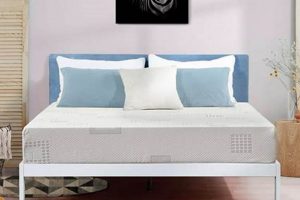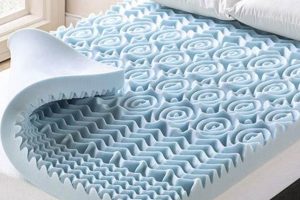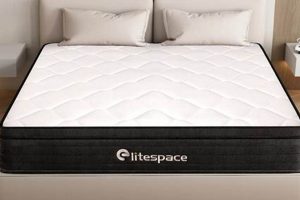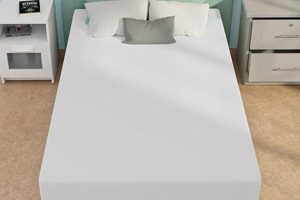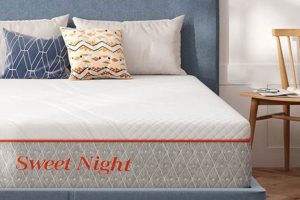A sleep surface addition, this product enhances comfort through a layer of viscoelastic foam, measuring two inches in thickness. Its primary function is to modify the feel of an existing mattress. For instance, a firm mattress can be softened by the addition of this supplementary layer.
The significance of this type of bedding accessory lies in its ability to improve sleep quality and alleviate pressure points. Historically, individuals sought solutions to improve the comfort of their beds. The development of viscoelastic foam offered a conforming surface that distributes weight more evenly, leading to enhanced rest and reduced discomfort. Its benefits include increased comfort, potential pain relief, and extending the lifespan of the underlying mattress.
The subsequent sections will delve into the specific attributes, considerations for purchase, and care recommendations for optimizing the use of this particular bedding enhancement. Further discussion will address its impact on sleep quality and overall user satisfaction.
Optimizing the Use of Viscoelastic Bedding Enhancements
This section outlines key considerations for maximizing the benefits and longevity of a two-inch viscoelastic foam bedding layer.
Tip 1: Assess Existing Mattress Condition: Before acquiring this foam layer, evaluate the state of the underlying mattress. If the existing mattress is excessively worn or sagging, the added layer may not provide the desired level of comfort and support. Addressing foundational issues is recommended.
Tip 2: Consider Density: Viscoelastic foam density affects its performance and durability. Higher-density options generally offer greater support and resist compression over time. Investigate density specifications to align with individual support requirements.
Tip 3: Evaluate Heat Retention: Viscoelastic foam can retain heat. If overheating is a concern, explore options incorporating cooling technologies, such as gel infusions or open-cell structures, designed to improve airflow.
Tip 4: Utilize a Protective Cover: Employ a breathable mattress protector. This shields the foam layer from spills, stains, and allergens, extending its lifespan and maintaining hygiene.
Tip 5: Rotate Periodically: To promote even wear, rotate the foam layer 180 degrees every few months. This helps prevent the formation of impressions in areas of concentrated pressure.
Tip 6: Adhere to Cleaning Guidelines: Consult the manufacturer’s instructions for cleaning. Avoid harsh chemicals or excessive moisture, which can damage the foam. Spot clean as needed using a mild detergent and allow to air dry thoroughly.
Tip 7: Ensure Proper Support: Use a bed frame that provides adequate support for both the mattress and the foam layer. A sagging or inadequate frame can compromise the structural integrity of the entire sleep system.
Implementing these strategies will contribute to enhanced comfort, extended product lifespan, and sustained satisfaction with the viscoelastic foam bedding layer.
The final section will provide a concluding perspective on the value and appropriate application of this specific type of bedding accessory.
1. Pressure Relief
Pressure relief, as it pertains to bedding, describes the ability of a sleep surface to minimize concentrated force on specific areas of the body. In the context of a two-inch viscoelastic foam bedding layer, this characteristic is paramount to its intended function and user benefit.
- Conforming Capability
Viscoelastic foam possesses the property of conforming to the contours of the body. This distributes weight across a wider surface area, thereby reducing peak pressure points at areas such as the hips, shoulders, and spine. The two-inch thickness provides a sufficient layer to effectively mold to these contours, offering noticeable relief compared to thinner alternatives or traditional innerspring mattresses.
- Viscoelastic Properties
The viscoelastic nature of the foam contributes significantly to pressure reduction. Upon initial compression, the material yields, allowing the body to sink slightly and uniformly. Subsequently, the foam exhibits a slow recovery, gradually returning to its original shape when pressure is removed. This characteristic minimizes rebound force and maintains consistent support throughout the night.
- Impact on Circulation
Prolonged pressure on certain areas of the body can impede blood circulation, leading to discomfort and potentially contributing to tossing and turning during sleep. The pressure-relieving properties of the foam facilitate improved blood flow by reducing localized compression. This can result in a more restful and uninterrupted sleep experience.
- Alleviation of Pain
Individuals experiencing musculoskeletal pain, such as back pain or arthritis, may benefit from the pressure-relieving characteristics. By minimizing stress on sensitive joints and tissues, the foam can contribute to a reduction in pain symptoms and improve overall comfort during sleep. However, it is important to note that this is not a substitute for medical treatment.
The effectiveness of the two-inch viscoelastic foam layer in delivering pressure relief is directly related to its density, quality, and the condition of the underlying mattress. When these factors are appropriately considered, the layer can significantly enhance sleep comfort and contribute to overall well-being by mitigating pressure-related discomfort.
2. Firmness Adjustment
Firmness adjustment refers to the capability of a sleep surface to modify the perceived hardness or softness of an existing mattress. A two-inch viscoelastic foam bedding layer serves as a practical tool for achieving this modification, altering the overall sleep experience.
- Softening Effect
The primary function of a two-inch viscoelastic foam layer is to soften a sleep surface that is considered too firm. The conforming nature of the foam allows it to yield under pressure, creating a more cushioned feel. Individuals who find their existing mattress uncomfortably hard may find relief through this added layer. The degree of softening depends on the foam’s density and the initial firmness of the mattress.
- Subjective Perception
Firmness is a subjective experience, varying significantly between individuals. Factors such as body weight, sleeping position, and personal preference influence the perception of firmness. A two-inch viscoelastic foam layer can provide a customizable solution, allowing individuals to fine-tune the firmness level to align with their specific needs and preferences. It offers a relatively inexpensive alternative to replacing an entire mattress.
- Impact on Support
While primarily intended for firmness adjustment, a two-inch viscoelastic foam layer can subtly impact support. By conforming to the body’s contours, it may improve spinal alignment for certain individuals. However, it is crucial to acknowledge that it does not address underlying support issues within the existing mattress. If the mattress lacks adequate support, the added foam layer may only mask the problem rather than resolve it.
- Considerations for Durability
The long-term effectiveness of the firmness adjustment is contingent on the quality and density of the foam. Lower-density foams are more prone to compression over time, resulting in a diminished softening effect. Selecting a higher-density foam can ensure sustained firmness adjustment and extended product lifespan. Regular rotation of the foam layer can also contribute to more even wear and maintained performance.
The application of a two-inch viscoelastic foam bedding layer for firmness adjustment provides a targeted solution for enhancing sleep comfort. However, its suitability is dependent on individual needs, the existing mattress condition, and careful consideration of foam characteristics. It serves as a modifying agent, altering the surface feel, rather than a comprehensive solution for addressing fundamental support deficiencies.
3. Heat Retention
Heat retention is a significant consideration when evaluating the suitability of a two-inch viscoelastic foam bedding layer. The inherent properties of viscoelastic foam can impede airflow, potentially leading to elevated sleep surface temperatures. Understanding the mechanisms and mitigations of heat retention is crucial for optimizing sleep comfort.
- Foam Density and Airflow
Higher-density viscoelastic foams, while offering increased support and durability, tend to exhibit reduced airflow compared to lower-density options. The tightly packed cell structure restricts the circulation of air, trapping heat generated by the body. This can result in a warmer sleep environment, potentially causing discomfort for some individuals. Conversely, lower-density foams generally allow for greater airflow, but may compromise on support and longevity.
- Closed-Cell Structure
Traditional viscoelastic foam features a predominantly closed-cell structure. This means that the individual foam cells are largely enclosed, hindering the movement of air within the material. The closed-cell structure contributes to the foam’s ability to conform to the body but simultaneously limits its breathability. This inherent characteristic makes heat retention a common concern associated with standard viscoelastic foam bedding layers.
- Mitigation Strategies: Gel Infusions
Manufacturers have implemented various strategies to address the issue of heat retention. One prevalent approach involves infusing the foam with gel particles. These gel particles are designed to absorb and dissipate heat, effectively reducing the overall temperature of the sleep surface. Gel-infused viscoelastic foam layers represent a common adaptation aimed at improving thermal regulation without sacrificing the comfort and support benefits of the material.
- Mitigation Strategies: Open-Cell Technology
Another approach to mitigate heat retention involves the use of open-cell viscoelastic foam. Open-cell foam features a more porous structure, allowing for increased airflow and improved breathability. This design facilitates the dissipation of heat and moisture, resulting in a cooler and more comfortable sleep environment. While open-cell foam may offer enhanced thermal regulation, it is important to consider its potential impact on the foam’s overall durability and support characteristics.
The relationship between heat retention and a two-inch viscoelastic foam bedding layer is complex and multifaceted. While the inherent properties of the material can contribute to increased sleep surface temperatures, various mitigation strategies, such as gel infusions and open-cell technology, have been developed to address this issue. Consumers should carefully consider their individual thermal preferences and evaluate the specific features of different viscoelastic foam layers to ensure optimal sleep comfort.
4. Support Level
The support level provided by a two-inch viscoelastic foam bedding layer is inextricably linked to its ability to enhance sleep quality and address specific user needs. This level directly influences spinal alignment, pressure distribution, and overall comfort, forming a critical component of its value proposition. An inadequate support level can negate potential benefits, while appropriate support contributes to a more restful and restorative sleep experience. For example, an individual with existing back pain requires a support level that maintains the natural curvature of the spine, preventing further aggravation of their condition. If the foam layer is too soft and offers insufficient resistance, it can lead to spinal misalignment and increased discomfort.
The practical significance of understanding the support level lies in its direct impact on user satisfaction and the effectiveness of the bedding layer as a solution. A lighter individual seeking a slight softening of a firm mattress might find sufficient support in a lower-density, two-inch foam layer. Conversely, a heavier individual or someone requiring more substantial support would necessitate a higher-density foam to prevent excessive sinking and maintain proper spinal alignment. This understanding allows consumers to make informed purchasing decisions aligned with their specific needs and body type. Choosing a product that fails to provide adequate support may result in discomfort, disrupted sleep, and ultimately, dissatisfaction with the purchase.
In summary, the support level is a crucial determinant of the overall effectiveness of a two-inch viscoelastic foam bedding layer. It influences spinal alignment, pressure distribution, and user comfort, and its adequacy is contingent on individual needs and body weight. The challenge lies in accurately assessing personal support requirements and selecting a product that aligns with those needs. Considering the interplay between foam density, thickness, and the condition of the underlying mattress is essential for optimizing the support level and achieving the desired sleep experience. A proper understanding of this relationship transforms the bedding layer from a mere comfort addition to a functionally supportive element in a comprehensive sleep system.
5. Thickness impact
The thickness of a viscoelastic foam bedding layer, particularly at two inches, significantly dictates its impact on sleep quality and comfort. This dimension is a key determinant of the degree to which the topper can modify the characteristics of the underlying mattress. A thicker layer, generally exceeding two inches, will exert a more pronounced change in firmness and pressure relief, while a thinner layer offers a more subtle alteration. The two-inch thickness represents a middle ground, aiming for a balance between noticeable enhancement and practical considerations such as cost and ease of handling.
In practical terms, a two-inch thickness can effectively soften a moderately firm mattress and provide a degree of pressure relief for individuals experiencing minor discomfort. For instance, a side sleeper might find that a two-inch topper alleviates pressure on the hips and shoulders, leading to improved sleep. However, this thickness may prove insufficient for individuals seeking a significant transformation of a very firm mattress or those requiring substantial pressure relief due to conditions such as fibromyalgia. The effectiveness is also contingent on the density of the foam, with higher-density foams providing more support despite the relatively limited thickness. Real-world examples include users reporting improved sleep quality and reduced back pain after adding a two-inch topper to a slightly aging mattress, effectively extending its lifespan and improving comfort without the expense of a new mattress.
Ultimately, the impact of the two-inch thickness is a compromise. It provides a tangible enhancement to comfort and support without the bulk and cost associated with thicker options. However, individuals with more specific or pronounced needs may require a different thickness to achieve their desired sleep experience. Evaluating personal requirements, the condition of the existing mattress, and the density of the foam is crucial to determining whether a two-inch viscoelastic foam bedding layer will deliver the desired thickness impact. The challenge lies in matching expectations to the inherent limitations of this specific dimension, recognizing that it offers a moderate solution for a range of comfort and support needs.
Frequently Asked Questions
This section addresses common inquiries regarding the characteristics, applications, and maintenance of viscoelastic foam bedding layers with a two-inch profile.
Question 1: Does a 2-inch memory foam mattress topper effectively alleviate back pain?
A two-inch viscoelastic foam layer can provide pressure relief, potentially mitigating minor back pain. However, its effectiveness is contingent on the underlying mattress condition and the severity of the pain. It is not a substitute for medical treatment.
Question 2: How long can a 2-inch memory foam mattress topper be expected to last?
The lifespan is influenced by foam density, usage frequency, and maintenance practices. Higher-density options, with proper care, may last three to five years. Lower-density options typically have a shorter lifespan.
Question 3: Is a 2-inch memory foam mattress topper suitable for all sleeping positions?
It can accommodate various sleeping positions. However, side sleepers may experience greater benefit from the pressure relief it offers on hips and shoulders. Stomach sleepers may find it too soft, potentially leading to spinal misalignment.
Question 4: How should a 2-inch memory foam mattress topper be cleaned?
Spot cleaning with a mild detergent is recommended. Avoid harsh chemicals or excessive moisture. Allow to air dry thoroughly. Consult the manufacturer’s instructions for specific cleaning guidelines.
Question 5: Will a 2-inch memory foam mattress topper make a mattress too hot?
Viscoelastic foam can retain heat. Options with gel infusions or open-cell structures may mitigate this. Consider individual thermal preferences when selecting a product.
Question 6: Can a 2-inch memory foam mattress topper correct a sagging mattress?
It can provide temporary comfort enhancement but will not correct significant sagging. Addressing the underlying issue with the mattress is recommended for long-term support.
In conclusion, the suitability of a two-inch viscoelastic foam bedding layer depends on individual needs, preferences, and the existing mattress condition. Careful consideration of these factors is essential for maximizing its potential benefits.
The subsequent section will explore user reviews and testimonials, offering real-world perspectives on the performance of this specific bedding accessory.
Concluding Assessment of 2 inch memory foam mattress topper
This examination has delineated the attributes, benefits, and limitations of a “2 inch memory foam mattress topper.” The discussion encompassed pressure relief, firmness adjustment, heat retention considerations, support level implications, and the overall impact of its specific thickness. It is evident that this bedding accessory offers a moderate enhancement to sleep comfort, providing a balance between support and softness. Its suitability, however, remains contingent on individual needs, pre-existing mattress conditions, and a discerning evaluation of foam density and construction.
The ultimate determination of value rests with the informed consumer. Understanding the nuanced interplay of factors outlined herein enables a judicious assessment. While the “2 inch memory foam mattress topper” presents a cost-effective avenue for modifying sleep surfaces, it is imperative to temper expectations and align them with the product’s inherent capabilities. Future advancements in material science may address current limitations, potentially expanding its applicability. The purchase decision should be grounded in realistic projections, prioritizing a solution that genuinely addresses individual sleep-related concerns.


